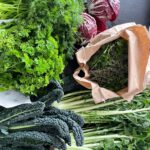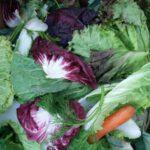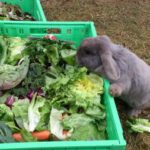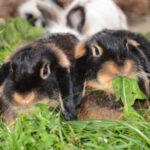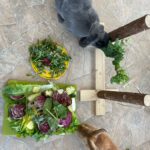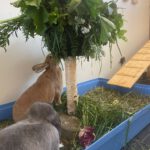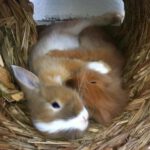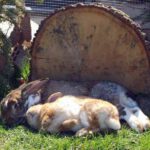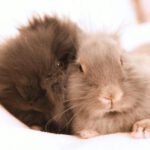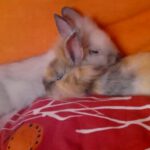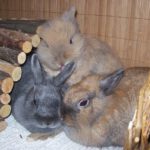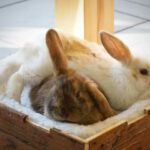
Rabbit Nutrition and Tooth Wear
The incisors and molars in rabbits grow throughout their lives and must be worn down at the same rate they grow (Kamphues 2004).
There are varying reports on the speed of growth of the incisors in different studies. At the Free University of Berlin, the average growth rate was found to be 1.47 mm per week for the lower incisors and 1.59 mm per week for the upper incisors (Bucher 1994).
Food Intake
By the incisors sliding past each other, food is cut and, with the help of the tongue, the rabbit takes it in and moves it between the molars (Hörnicke 1978).
The molars perform approximately 3.5 to 5 lateral chewing movements per second (Schley 1985; Hörnicke 1978). Chewing always occurs on one side, and after 800 to 1000 chewing movements, the side is switched (Morimonto 1985).
Wear of the Molars
The molars wear down against each other during chewing, not – as is often mistakenly assumed – against the „hard“ food (unless the food is harder than the teeth).
Through continuous tongue movements, the food gradually moves towards the throat and is eventually swallowed.
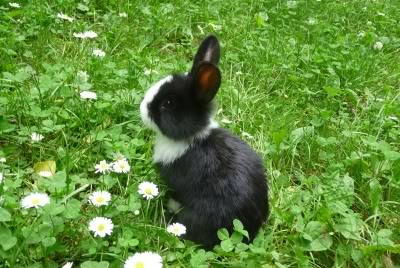
Rabbits that can graze throughout the day wear down their teeth most effectively.
„The longer the animals are engaged in food intake (biting, chewing, grinding), the more beneficial it is for tooth wear (teeth only wear down against each other, not against the food).“ Kamphues 2004
Therefore, it is up to the owner to ensure optimal tooth wear by offering suitable food that encourages plenty of chewing activity.
Many rabbits also rub their teeth together without food by making monotonous chewing movements, which also contributes to tooth wear.
Hard bread, by the way, is unsuitable for good tooth wear. It was once believed that the hardness of food contributed to tooth wear, but the chewing duration is what really matters, as hard bread is much softer than the teeth. Since hard bread quickly makes the rabbit feel full, it will chew very little, causing the teeth to wear down too slowly and unfavorably.
The food would need to be as hard as or harder than the tooth in order to contribute to tooth wear. Only a few substances, such as diamonds or silicates, meet this criterion. This is why rabbits wear down their teeth against each other while chewing, not against the food.
To encourage rabbits to chew, it is important to offer only very well-structured food. If the food is finely ground (pellets, dry food, extrudates, hay pellets…), the high crude fiber content is meaningless; only structured, unground fiber is nutritionally beneficial (Pairet 1986) and will be chewed for a sufficient amount of time to break it down.
„The coarser the food and/or the longer the structure of the plant fibers, the greater the time required for food intake. The more time spent eating, the better the tooth wear and the utilization of the gastrointestinal tract, and the less boredom there is.“
Fr. Dr. Jutta Hein
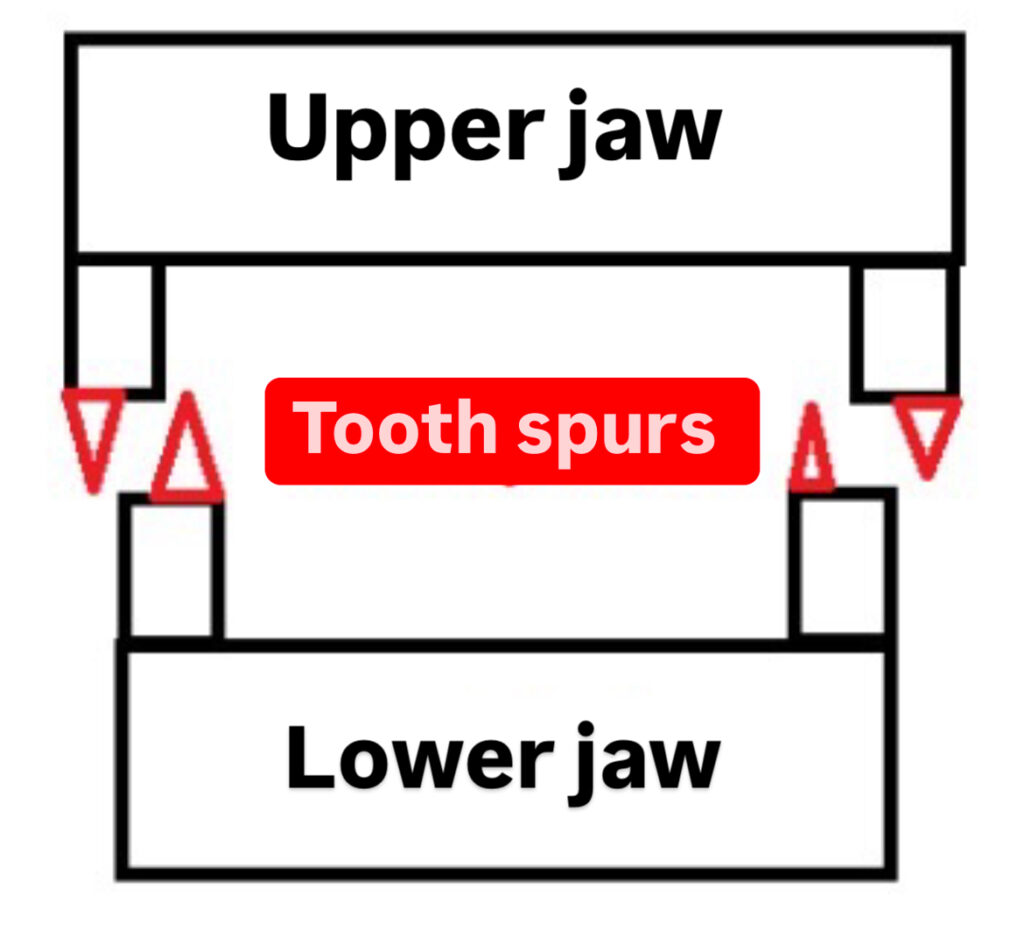
Pellet food is already ground, so it is chewed very little. In contrast, fresh and rough forage is structurally rich and unground, requiring thorough grinding with the teeth.
Moreover, commercial prepared foods, grains, dried vegetables, and treats are chewed differently than fresh food. They are simply „squished“ rather than ground between the teeth. This increases the pressure on the jaw, potentially leading to dental problems such as retrograde tooth growth (Böhmer 2014).
Food that is simply „squished“ and not ground encourages the development of dental spurs. Rabbits have a wider upper jaw than lower jaw, meaning that when they don’t properly grind their food, only part of the upper teeth come into contact with the lower teeth, while the other part remains unused and doesn’t wear down (see diagram). When food is ground properly, the rest of the tooth is also worn down. This is why dental spurs in the lower jaw always grow towards the tongue (and can even form a bridge over it), while dental hooks in the upper jaw can penetrate the cheeks.
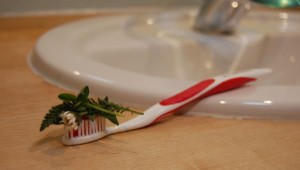
Intake times for 1g of dry matter (Schlolaut 2003):
- Hay: 4.72–12.2 minutes
- Grass: 6.84 minutes
- Hay pellets/cobs: 2.30 minutes
- Mixed feed: 1.40 minutes
Tastier food is generally preferred and consumed in larger quantities compared to less appetizing food. For example, rabbits that are allowed to eat clover ad libitum consume almost twice as much dry matter per day as those fed hay (Schlolaut 2003).
If the food is relatively high in energy (such as dry food, snacks, or hard bread), the rabbit only needs to eat a small amount to feel full and will perform relatively few chewing movements – leading to dental problems (Hein 2007; Wolf & Kamphues 1995).
Even if an animal doesn’t have to chew much because it is fed food that is higher in energy than greens, the teeth will still grow.
If guinea pigs and rabbits are fed food that makes them feel full more quickly than the food nature intended, they will chew less, and their teeth will grow too long. A common but mistaken belief is that one must offer the animals something „hard,“ such as dry bread, to promote tooth wear. This is not correct, because the only thing hard enough to wear down a tooth is another tooth. This wear, tooth on tooth, happens during normal chewing.
The dental structure of rabbits and guinea pigs is one of the most specialized in the animal kingdom. The shape of their teeth and the structure of the tooth and root are highly specialized for grinding soft, fresh, leafy food. If these animals are given food whose structure doesn’t match their highly specialized dentition, and which cannot be broken down with their natural chewing movements, then the teeth and tooth roots are improperly stressed, which can lead to serious dental problems. Improper feeding is therefore the cause of most dental issues in rabbits and guinea pigs.
„Misalignments“ are almost never congenital but are caused by insufficient tooth wear or improper stresses.
Dr. med. vet. Diana Ruf, source
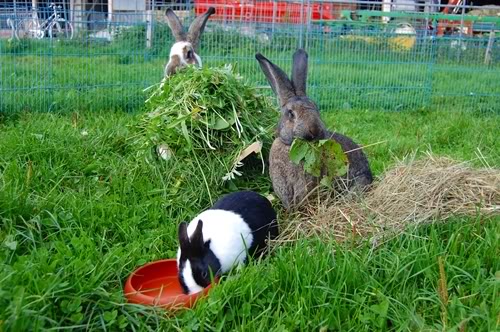
In addition to the direct grinding of teeth against each other, another important factor for molar wear is silica (Fritz 2007), also known as silicate, silicon, or silicic acid.
Biogenic silicates are present in all plants, such as meadow herbs, grasses, vegetables, fruits, seeds, and bark. Moreover, rabbits also ingest a significant amount of silicate from dirt particles in their food (silicates from sand, dust, soil, earth, etc.).
Silicon has a crystalline structure, which creates a sanding effect on the tooth surface during chewing, similar to sandpaper. Silicate is harder than teeth and thus has the ability to shape them. Other substances in the diet can only affect tooth wear if they are harder than the teeth themselves.
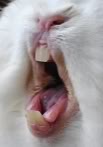
Silicon content in dry matter (Roth 2007):
- Hay: 640 mg/kg
- Meadow plant hay: 1820 mg/kg
When meadow plants are dried to make hay, much of the silicate is lost due to structural changes.
Some manufacturers already promote their products by emphasizing the silicate content and its effect on tooth wear (e.g., Versele-Laga Cuni Complete (Rabbit) food).
Wear of the Incisors
The widespread belief that branches and other chewing objects help wear down the incisors is a misconception.
**“The wear of the incisors occurs primarily through contact with each other during gnawing and chewing, and not, as is often mistakenly believed, through abrasion on chewed objects. While providing materials for gnawing is useful for encouraging the activity, harder materials (e.g., chewing stones) do not lead to significantly greater wear.
Normally, tooth wear matches tooth growth, maintaining a consistent tooth length. However, this balance only works if there is sufficient chewing activity.“**
— Schreyer 2009
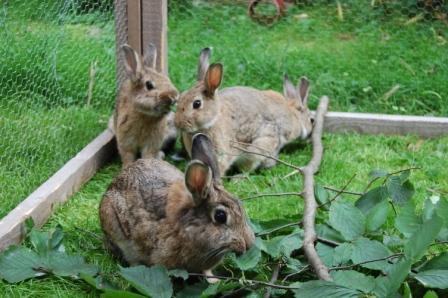
It is not actually the hardness of the food that is significant for the wear of the front teeth, but rather the chewing activity. The incisors also wear down by rubbing against each other, not against the food (Wolf, Kamphues & Soltan 1995).
Thus, the same principle applies to the wear of the front teeth as to molar wear. With normal chewing movements of the molars, properly aligned incisors are also worn down.
Dental Issues? Supporting Tooth Wear
Rabbits with dental issues can be supported through dietary adjustments. This can sometimes significantly extend the intervals between dental treatments or even make regular treatments unnecessary. However, the specific dental condition determines the approach. First, the teeth should be X-rayed and professionally filed under anesthesia according to reference lines. Ideally, a quality treatment can restore the teeth to their normal function, improving natural tooth wear. It’s essential to identify and treat the root cause of the dental problem.
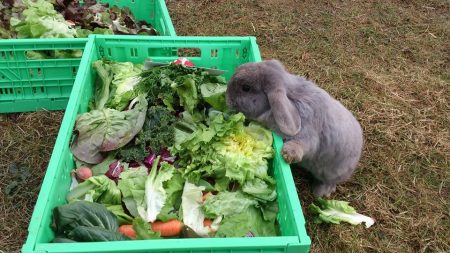
How to Support Tooth Wear:
Tooth wear is best supported by leafy, fresh food that is readily eaten, low in energy, high in long fiber/structure, and available at all times. A high content of silica further enhances this effect.
Pure Meadow Diet: Fresh meadow herbs and grasses are ideal, as they are eaten in large amounts, chewed thoroughly, and are rich in silica. Compared to hay, they have the advantage of being consumed in much greater quantities (due to their 80% water content) and are less filling. Many rabbit owners find that rabbits with dental issues require tooth corrections up to three times less frequently in summer when fed a pure meadow diet compared to winter.
Alternative Leafy Vegetables: Vegetables tend to be lower in silica and less fibrous, so fresh meadow forage is generally preferable. In winter, you can substitute leafy greens (such as bitter lettuces, cabbage, celery stalks, spinach, dandelion greens) and vegetable tops (carrot greens, kohlrabi leaves, cauliflower leaves, celery greens). It’s best to cut these into strips. Root vegetables contribute little to tooth wear and should only be given sparingly.
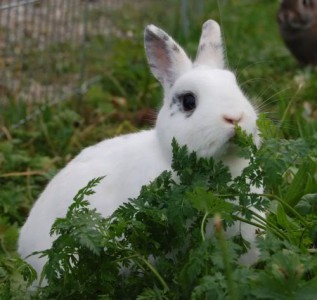
Natural green forage is ideal for supporting tooth wear.
Aromatic Herbs: Fresh herbs are excellent for supporting tooth wear.
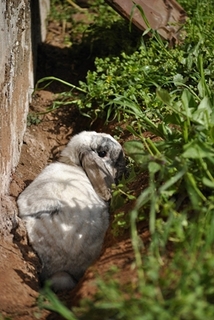
Using Silica: Many plants contain silica in their stems, providing structure and additional toughness. Plants particularly high in silicon include horsetail, bamboo, broadleaf plantain, nettle, hemp-nettle, knotweed, lungwort, sedges, narrowleaf plantain, grasses, and others. Some owners have had great success with small amounts of horsetail supplementation, although it has toxic look-alikes (other horsetail species) and must be identified carefully. It’s also available dried. Use in moderation, as too much can lead to Vitamin B1 deficiency, causing seizures or paralysis. Note that drying reduces silica content. Potted bamboo can thrive on a balcony, offering fresh greenery even in winter.
Soil as a Source of Silica: For added tooth wear, green fodder can be lightly sprayed with water and dusted with mineral clay. Indoor rabbits often have limited exposure to soil, so planted trays or cage liners, as well as products like „Herb Meadow“ from JR Farm, can be used to provide some soil intake.
Avoid Dry Food: Avoid dry food, store-bought treats, hard bread, or cereal flakes. These are unsuitable for even healthy rabbits and can worsen dental issues significantly. Learn about healthy nutrition; fresh herbs or a small piece of fruit make better treats.

Caution with rabbits that have severe dental malocclusions: Your rabbit may no longer be able to properly chew its food.
Sources:
Anonymus: Kaninchen: richtiges Futter für optimalen Zahnabrieb. Tierpunkt, 2007
Beuch-Ahrendt, A.: Ernährung von Kaninchen und Meerschweinchen, Degus und Chinchillas. 2005
Böhmer, E.: Warum leiden Hauskaninchen so häufig untan Gebiss- und Verdauungsproblemen? curoxray, 2014
Böhmer E.: Zahnheilkunde bei Kaninchen und Nagern. Lehrbuch und Atlas. Schattauer-Verlag 2010
Bucher, L.: Fütterungsbedingte Einflüsse auf Wachstum und Abrieb von Schneidezähnen bei Zwergkaninchen. Freie Universität Berlin, 1994
Ewringmann, A.: Zahnerkrankungen beim Heimtier. Anatomische und physiologische Besonderheiten
Fritz, J.: Allometrie der Kotpartikelgröße von Pflanzenfressenden Säugern, Reptilien und Vögeln, München, Ludwig-Maximilians-Universität 2007
Glöckner, B.: Untersuchungen zur Ätiologie und Behandlung von Zahn- und Kiefererkrankungen beim Heimtierkaninchen; Berlin 2002
Handl, S.: Artgerechte Haltung und Fütterung von kleinen Heimtieren. Institut für Ernährung, 2008
Hartmann, M. (2007). Zahnextraktion hypsodonter Zähne bei Nagern und Hasenartigen. veterinär spiegel, 17(01), 22-27.
Hörnicke, H.: Futteraufnahme beim Kaninchen – Ablauf und Regulation. Übers. Tierernährung, 1978
Kamphues, J.: Kaninchen und Meerschweinchen: Häufige Fütterungsfehler und Hinweise zur Diätetik, 2004
Morimonto, T./Inoue, T./Nakamura, T./Kawamura, T.: Characteristics of rhythmic jaw movements of the rabbit, 1985
Neumaier, L.: Stuktur in der Ernährung. http://www.heimtierwissen.de/Seiten/Ernaehrung/Struktur.html [Abgerufen am 13.02.2019]
Pairet, M./Bouyssou, T/Auvergne, A/Candau, M./Ruckebusch, Y.: Reproduktion Nutr. Dévelop, 1986
Roth, C./Ganter, M.: Urolithiasis bei einem Lamawallach – Ein Fallbericht. Tierärztliche Hochschule Hannover, 2007
Schley, P.: Kaninchen. Ulmer. Stuttgart 1985
Schlolaut, W.: Das große Buch vom Kaninchen. 3. überarb. Auflage. DLG-Verlag GmBH, 2003
Schreyer, J.: Zahnerkrankungen bei Kaninchen und Nagern. Universität Leipzig, 2009
Wiesenmüller, W./Fakete, S.: Ernährung der Kaninchen. In: Ernährung monogastrischer Nutztiere. Gustav Fischer Verlag, Jena 1993
Wolf, P./Kampues, J.:Kritische Einschätzung kommerzieller Ergänzungspräparate
für Kaninchen,Meerschweinchen. Institut für Tierernährung, Tierärztliche Hochschule Hannover, 2003
Wolf, P/Kamphues, J./Soltan, M.: Vergleichende Untersuchungen zu Fütterungseinflüssen auf die Entwicklung der Schneidezahnlängen bei Kaninchen, Chinchillas und Ratten. 1995
Wolf, P/Kamphues, J.:Probleme der art- und bedarfsgerechten Ernährung kleiner Nager als Heimtiere. Prakt. Tierarzt, 1995
Wolf, P/Bucher, L./Kamphues, J.:Die Futter-, Energie- und Wasseraufnahme von Zwergkaninchen unter praxisüblichen Fütterungsbedingungen. 1999




